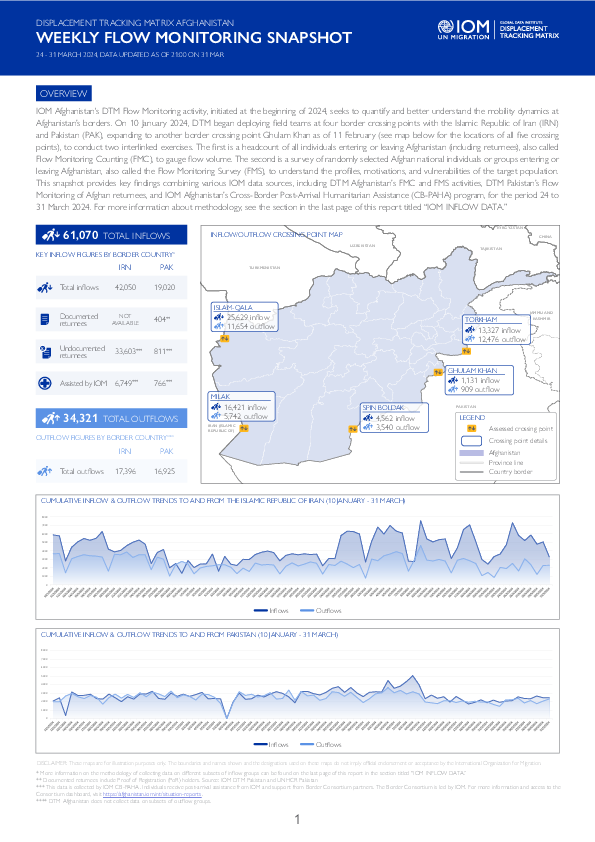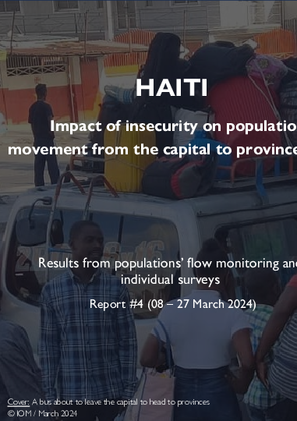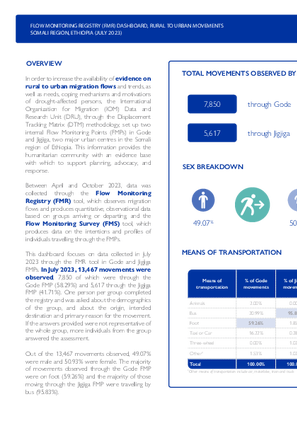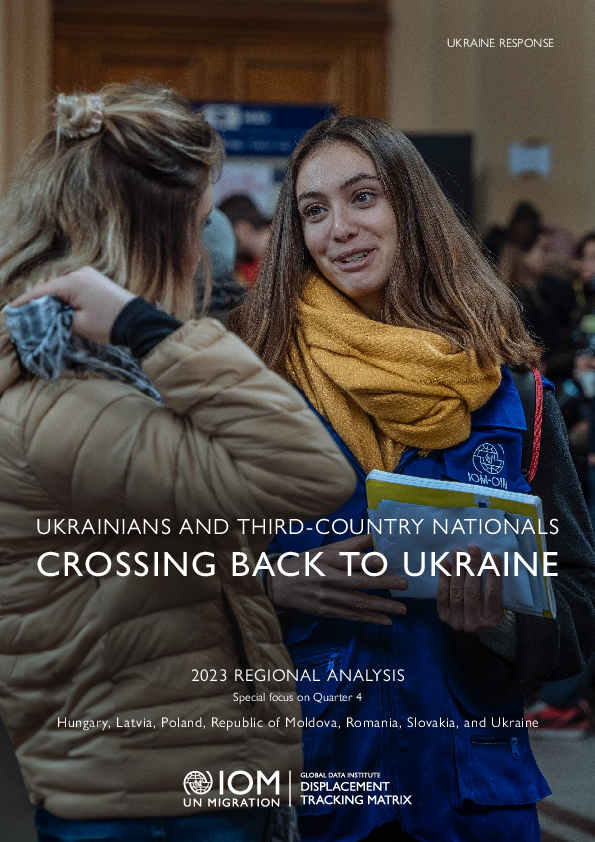-
Countries
-
Data and Analysis
-
Special Focus
-
Crisis Responses
Flow Monitoring

Contact
DTM Pakistan, DTMPakistan@iom.int
Language
English
Location
Pakistan
Period Covered
Mar 16 2024
Mar 31 2024
Activity
- Flow Monitoring
The International Organization for Migration (IOM) in Pakistan collects data on the outflows of Afghans at the Torkham (Khyber Pakhtunkhwa), Badini, Bahramcha and Chaman (Balochistan) border crossing points (BCPs) to better understand the movements of Afghans returning to Afghanistan. The data presented below is harmonised with those from the United Nations High Commissioner for Refugees (UNHCR), who also cover Ghulam Khan (Khyber Pakhtunkhwa). On 26 September 2023, the Ministry of Interior in Pakistan announced its decision to enact its “Illegal Foreigners’ Repatriation Plan (IFRP)”. Between 16 and 31 March 2024, 7,532 Afghan nationals returned to Afghanistan, including 5,057 through the Torkham BCP, 1,149 through the Chaman BCP, 1326 through the Ghulam Khan BCP, while no Afghan nationals returned through the Badini BCP. In addition, border authorities deported 74 individuals due to a lack of valid documentation. Since 1 January 2024, IOM identified 54,227 returns at the four BCPs.
DTM Europe gathers, validates and disseminates information on migrants and refugees travelling through the Mediterranean, Western African Atlantic, and Western Balkan routes to Europe. Key routes include:
- Eastern Mediterranean route (EMR): Bulgaria, Cyprus and Greece
- Central Mediterranean route (CMR): Italy and Malta
- Western Mediterranean route (WMR): Peninsular Coasts of Spain, Balearic Islands, Ceuta and Melilla
- Western African Atlantic route (WAAR): Canary Islands of Spain
DTM also monitors data on migrants in transit through the Western Balkans (WB) region (Albania, Bosnia and Herzegovina, Croatia, Montenegro, North Macedonia, Serbia, Slovenia, Romania, and Kosovo*). These are considered separately to prevent to the extent possible the double counting of the same persons that cross multiple borders to reach Europe.
This report presents the latest available data and trends, focusing on 2023:
- Mixed Migration Flows to Europe
- Migrant Flows Monitoring in the Republic of Türkiye
- First Arrival countries (Italy, Greece, Spain) and other countries of first arrival (Bulgaria, Cyprus and Malta)
- Transits through the Western Balkan region
- Migrants' presence, in Europe and the Republic of Türkiye

Contact
ROPretoriaRMDHub@iom.int
Language
English
Location
Malawi
Period Covered
Feb 01 2024
Feb 29 2024
Activity
- Flow Monitoring
Over the reporting period, a total of 2,754 cross-border movements were observed at the Flow Monitoring Points (FMPs). The average daily number flows was 131. This represented an 2 per cent decrease compared to January, during which 134 individual movements were observed on a daily basis. Mozambique (59%), Malawi (40%), South Africa (<1%) and United Republic of Tanzania (<1%) were the main countries of departure, while Malawi (58%), Mozambique (41%), Zimbabwe (<1%) and South Africa (<1%) were the main countries of intended destination of individuals passing through the different FMPs. Out of 2,754 individuals observed, 65 per cent were males and 35 per cent were females. There were 35 women who were visibly pregnant. Boys and girls (males and females below 18) made up 17 per cent of individuals observed. Of the 467 children observed, 10 were unaccompanied boys and none were unaccompanied girls. However, this information is based on direct observation and self-reporting, and therefore is likely under-reported.

Contact
DTM Nigeria, iomnigeriadtm@iom.int
Language
English
Location
Nigeria
Period Covered
Jan 01 2024
Jan 31 2024
Activity
- Flow Monitoring
This report presents the data for January 2024, collected through direct interviews and direct observation by DTM enumerators and triangulated via a network of key informants. It highlights the number of herders and their herds identified at 51 counting points. Notably, this enumeration included areas within the Kachia, Kaura, Kaita, and Faskari Local Government Areas (LGAs) of Kaduna and Katsina states, under the auspices of the UN Peacebuilding Fund. Additionally, it extended to Batsari, Jibia, Kankara, and Dansuma LGAs of Katsina state, which were supported by the European Union Fund.
In January 2024, Transhumance Flow Monitoring tool identified 3,548 herders in Kaduna State and 873 herders in Katsina State. The animal count was estimated at 72,011 for Kaduna State and 21,422 for Katsina State. Notably, 92 per cent of the total number of herders departed from states within Nigeria, while the remaining 8 per cent departed from Niger.

Contact
DTMAfghanistan@iom.int
Language
English
Location
Afghanistan
Period Covered
Mar 24 2024
Mar 31 2024
Activity
- Survey
- Flow Monitoring Survey
- Flow Monitoring
IOM Afghanistan's DTM Flow Monitoring activity, initiated at the beginning of 2024, seeks to quantify and better understand the mobility dynamics at Afghanistan’s borders. On 10 January 2024, DTM began deploying field teams at four border crossing points with the Islamic Republic of Iran (IRN) and Pakistan (PAK), expanding to another border crossing point Ghulam Khan as of 11 February (see map below for the locations of all five crossing points), to conduct two interlinked exercises. The first is a headcount of all individuals entering or leaving Afghanistan (including returnees), also called Flow Monitoring Counting (FMC), to gauge flow volume. The second is a survey of randomly selected Afghan national individuals or groups entering or leaving Afghanistan, also called the Flow Monitoring Survey (FMS), to understand the profiles, motivations, and vulnerabilities of the target population. This snapshot provides key findings combining various IOM data sources, including DTM Afghanistan’s FMC and FMS activities, DTM Pakistan’s Flow Monitoring of Afghan returnees, and IOM Afghanistan’s Cross-Border Post-Arrival Humanitarian Assistance (CB-PAHA) program, for the period 24 to 31 March 2024. For more information about methodology, see the section in the last page of this report titled “IOM INFLOW DATA.”
The Ukrainians and Third Country Nationals Crossing Back to Ukraine report presents findings from face-to-face interviews with individuals crossing back into Ukraine from five neighboring countries (Hungary, Poland, the Republic of Moldova, Romania, and Slovakia).
The findings in this report are based off on 27,653 surveys collected by DTM in 2023 and focuses in particular on the 6,086 surveys of adult individuals going to Ukraine during the fourth quarter of 2023 (October and December, Q4). Almost all (99%) of those who surveyed were Ukrainians, and a very small proportion (1%) were Third-Country Nationals (TCNs).
In Q4 of 2023, 31 per cent of Ukrainian respondents were prospective returnees (intended to stay in Ukraine), while 49 per cent planned to go for a short visit (short-time visitors). Another 20 per cent were unsure about the length of their visit.
The report delves into the socio-demographic profiles, reasons for return, duration of displacement, oblasts of origin and destination, needs and assistance, and experiences of discrimination of the surveyed individuals. The report also provides information on individuals who have already returned to Ukraine after a period of displacement abroad as well as those in Latvia who plan to transit through the Russian Federation to reach areas of non-government-controlled areas in Ukraine.

Contact
DTM Haiti, dtmhaiti@iom.int
Language
English
Location
Haiti
Period Covered
Mar 08 2024
Mar 27 2024
Activity
- Survey
- Flow Monitoring Survey
- Flow Monitoring
In recent weeks, armed attacks have intensified in the Metropolitan Area of Port-Au-Prince (MAPAP), the capital of Haiti. In addition to creating displacement within the MAPAP, attacks and generalized insecurity are pushing more and more people to leave the capital to find refuge in provinces, taking the risks of passing through gangs-controlled routes. In order to monitor these movements towards provinces and inform appropriate response strategies, DTM has launched data collection at several of the most used bus stations in the capital (see page 5 for more details on the methodology). Since the start of this activity, on 8 March, until 27 March, this activity allowed to observe the movements of 53,125 people leaving the MAPAP (see pages 3 and 4 for more details on the profile of these people ). The majority of them (61%) took means of transport heading towards the Grand Sud departments (Grande’Anse, South, Nippes and South-East). It should be noted that this region already hosts more than 116,000 people who had in vast majority, fled the MAPAP in recent months (see the report on displacement in the Grand Sud).
It should be emphasized that provinces do not have sufficient infrastructures and host communities do not have sufficient resources that can enable them to cope with these massive displacement flows coming from the capital.

Contact
DTM Ethiopia, DTMEthiopia@iom.int
Language
English
Location
Ethiopia
Period Covered
Jul 01 2023
Jul 31 2023
Activity
- Flow Monitoring
In order to increase the availability of evidence on rural to urban migration flows and trends, as well as needs, coping mechanisms and motivations of drought-affected persons, the International Organization for Migration (IOM) Data and Research Unit (DRU), through the Displacement Tracking Matrix (DTM) methodology, set up and piloted two internal Flow Monitoring Points (FMPs) in Gode and Jigjiga, two major urban centres in the Somali region of Ethiopia. The pilot ran from June 2023 through August 2023.
This dashboard focuses on data collected in July 2023 through the FMR tool in Gode and Jigjiga FMPs. In July 2023, 13,467 movements were observed, 7,850 of which were through the Gode FMP (58.29%) and 5,617 through the Jigjiga FMP (41.71%).

Contact
DTMAfghanistan@iom.int
Language
English
Location
Afghanistan
Period Covered
Mar 17 2024
Mar 23 2024
Activity
- Survey
- Flow Monitoring Survey
- Flow Monitoring
IOM Afghanistan's DTM Flow Monitoring activity, initiated at the beginning of 2024, seeks to quantify and better understand the mobility dynamics at Afghanistan’s borders. On 10 January 2024, DTM began deploying field teams at four border crossing points with the Islamic Republic of Iran (IRN) and Pakistan (PAK), expanding to another border crossing point Ghulam Khan as of 11 February (see map below for the locations of all five crossing points), to conduct two interlinked exercises. The first is a headcount of all individuals entering or leaving Afghanistan (including returnees), also called Flow Monitoring Counting (FMC), to gauge flow volume. The second is a survey of randomly selected Afghan national individuals or groups entering or leaving Afghanistan, also called the Flow Monitoring Survey (FMS), to understand the profiles, motivations, and vulnerabilities of the target population. This snapshot provides key findings combining various IOM data sources, including DTM Afghanistan’s FMC and FMS activities, DTM Pakistan’s Flow Monitoring of Afghan returnees, and IOM Afghanistan’s Cross-Border Post-Arrival Humanitarian Assistance (CB-PAHA) program, for the period 17 to 23 March 2024. For more information about methodology, see the section in the last page of this report titled “IOM INFLOW DATA.”

Contact
DTM Ethiopia, DTMEthiopia@iom.int
Language
English
Location
Ethiopia
Period Covered
Jan 01 2024
Jan 31 2024
Activity
- Flow Monitoring
In January 2024, a total of 40,464 movements were observed across the six flow monitoring points (FMPs) in Ethiopia. This represents a 5.7% increase in daily average movements in comparison with December 2023 when an average of 1,235 movements per day were observed.
Outgoing movements (63%) during January decreased while incoming movements (37%) increased compared to the previous month, mainly due to increased incoming flows of returning migrants to Ethiopia through different entry points. A total of 25,373 outgoing movements were observed, out of which 12,558 (49.5%) were heading to Saudi Arabia, 5,404 (21.3%) were going to Kenya, 2,182 (8.6%) to Djibouti, 1,682 (6.6%) to Somalia, 1,005 (4%) to South Africa, 954 (3.8%) to Yemen, and 552 (2.2%) to Sudan, while remaining movements were heading to other Southern African, Middle Eastern, and North American countries.
At the same time, 15,091 incoming movements were observed, out of which 10,401 (68.9%) originated from Sudan, while 2,291 (15.2%) came from Kenya, 1,392 (9.2%) from Djibouti, 882 (5.8%) from Somalia and 125 (0.9%) came from other Middle Eastern and Horn of Africa countries. Most incoming movements were by Ethiopians (65.3%), followed by Sudanese nationals (33.5%). Returning Ethiopians departed from Sudan (52.7%), Kenya (23.1%), Djibouti (14%), Somalia (8.9%), Yemen (1.2%), and South Sudan (0.1%).
Pagination
- Previous page
- Page 20
- Next page

